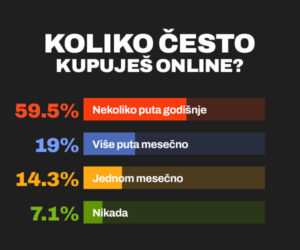On a sample of fifty young people between the ages of 18 and 20 from Serbia, we investigated what their online shopping really looks like. What are their habits, how do they make decisions, who do they trust and why. The results? Extremely interesting, for some things expected and on par with large global research, and for some items we are a bit surprised by the results.
How often do they shop online?
Although it is often believed that young people shop online all the time, research shows a different picture. As many as 59.5% of respondents shop online only a few times a year, while only 19% do so several times a month, and 14.3% once a month. Interestingly, 7.1% of them have never made an online purchase.
These data show that the digitally grown generation does not automatically mean digitally active when it comes to eCommerce. Even though they spend hours every day on TikTok, Instagram and YouTube, their confidence in online shopping is still building. Obstacles such as trust in delivery, payment security and returns still play a large role.
How do they find the products they want to buy?
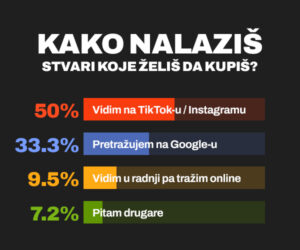
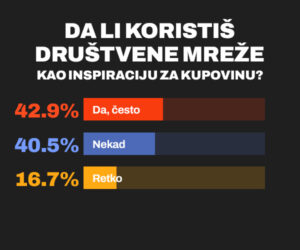
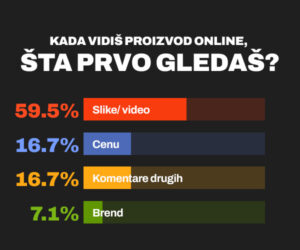
As many as 50% of respondents find products through TikTok and Instagram, while 33.3% use Google search. The rest combines offline and online, so 9.5% of respondents first see the product in a store and then look for it online, and 7.2% simply consult with friends.
This confirms a trend that the marketing industry has seen for some time now that TikTok has become the new search engine. In addition, new search methods are emerging, such as ChatGPT, which are further changing the way users find products and information. Unlike in previous years, today it is not just Google in the race for customers’ attention, but an entire ecosystem of new platforms and tools that shape consumer behavior.
For brands, this means that classic SEO is no longer enough. Instead of keywords and positions on Google, now the crucial algorithmic visibility is the presence in trends, authentic recommendations and short video formats that spread organically on networks. At the same time, UGC (user-generated content) becomes a central part of that visibility, especially for Gen Z, which trusts real users more than brands themselves.
What device do they use for online shopping?
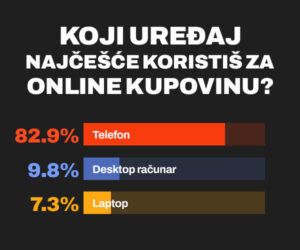
If anyone is still in a dilemma whether mobile-first is a real trend, this data breaks it down:
As many as 82.9% of young people buy by phone, while only 9.8% use a desktop and 7.3% use a laptop.
For the generation born with a phone, the desktop experience is practically non-existent. Starting from inspiration, search to purchase happens in a vertical format. That’s why design, checkout, photos and copy must be adapted to a fast and intuitive mobile experience. If something doesn’t work perfectly on the phone, it practically doesn’t exist for them.
Do influencers influence the purchase decision?
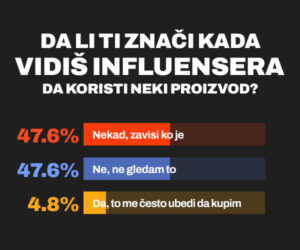
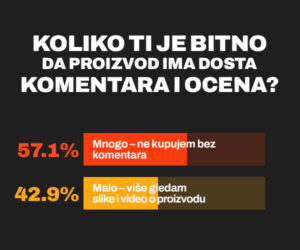
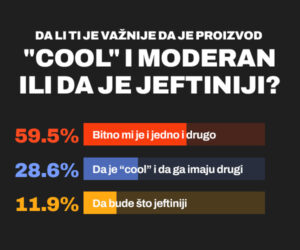
Almost half of the respondents (47.6%) say that they sometimes pay attention to which influencer uses a certain product, but it all depends on who it is.
Just as many (47.6%) say they are not interested in influencers at all, while only 4.8% admit that content often persuades them to buy a product.
In other words, Gen Z doesn’t trust everyone. Mass influencers and sponsored posts are no longer easy; authenticity and reality are key.
Micro-influencers, first-hand reviews and honest experiences have a much higher chance of influencing a decision than glamorous sponsored spots.
What annoys them the most about online shopping?
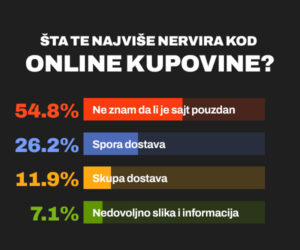
The biggest problem is not the price, but the trust.
54.8% of respondents say they don’t know if the site is trustworthy, which is a clear signal that trust has not yet been built.
This is followed by slow delivery (26.2%), expensive delivery (11.9%) and lack of information and pictures (7.1%).
Young people want everything to be clear, fast and without risk. For brands, this means that transparency becomes the new currency of trust:
realistic photos, user reviews, clear descriptions, fast communication and visible proof of reliability are crucial for a risk-averse generation.
Online VS shopping mall?
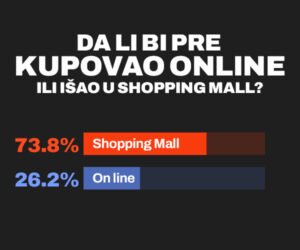
And finally – the biggest surprise: 73.8% of young people would rather go to a shopping mall than shop online, while only 26.2% would opt for online shopping.
For Gen Z, shopping is not just a transaction, it’s an experience.
Shopping mall is a place where they can try, see, take pictures and spend time with company. That’s why eCommerce must evolve: to combine the practicality of the online world with the experience and emotion of physical shopping. This means more video, more interactivity, more reality, and less “sterile” product pages.
Ipak, ovaj rezultat treba posmatrati sa dozom rezerve. Većina Gen Z generacije trenutno ima mnogo više slobodnog vremena, a fizička kupovina je i društveni događaj.
Kako budu ulazili u fazu života sa više obaveza fakultet, posao, porodica i druge čari modernog života, vrlo je verovatno da će se njihove navike prirodno pomeriti ka online kupovini, pre svega zbog praktičnosti i uštede vremena.
In other words, the question is not whether they will shop online, but how quickly the online world will manage to offer them the experience that walking through a mall offers them today.
Bottom line: What can brands learn from this?
This survey clearly shows that Generation Z and Alpha are not just “digital natives”, but critical digital users. They recognize what is realistic, they expect speed, but above all they look for trust and experience.
For eCommerce brands, this means the following:
- Authenticity >advertising.
- Speed and simplicity > complex loyalty systems.
- Trust > discounts and customer care.
- Trust > discounts and customer care.
The generation that grew up online doesn’t buy because they can but because they want to connect with a brand that understands their world.













